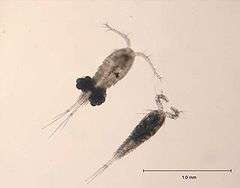Cyclops bicuspidatus
Cyclops bicuspidatus is a planktonic species of copepod found throughout the world, except Australia,[4] and characteristic of the Great Lakes of North America.[5] It is a deep water species found throughout the year with peak abundance occurring in May or June.[5] Males grow up to 0.8–1.0 millimetre (0.031–0.039 in) long, while females are larger at 0.9–1.6 mm (0.035–0.063 in).[6]
| Cyclops bicuspidatus | |
|---|---|
 | |
| Female (left) & male (right) C. b. thomasi | |
| Scientific classification | |
| Kingdom: | |
| Phylum: | |
| Subphylum: | |
| Class: | |
| Subclass: | |
| Order: | |
| Family: | |
| Genus: | |
| Species: | C. bicuspidatus |
| Binomial name | |
| Cyclops bicuspidatus | |
| Subspecies [1][2] | |
| |
| Synonyms [3] | |
|
Diacyclops bicuspidatus (Claus, 1857) | |
Distribution and classification
C. bicuspidatus has a cosmopolitan distribution, although several of its subspecies are more restricted, possibly representing cryptic species.[7] For example, most specimens from North America can be ascribed to C. b. thomasi[8] (= Diacyclops thomasi),[3] while C. b. limnoria is restricted to Lake Constance.[9] Taxonomy within the group is uncertain, and some subspecies may even belong to different genera.[4]
Ecology
In the Great Lakes, C. bicuspidatus is herbivorous until the fourth instar and omnivorous thereafter. Its prey includes ciliates, rotifers, small cladocera, young copepods and fish larvae. In turn, C. bicuspidatus is eaten by fish including the alewife, bass, bloaters, ciscoes, carpsuckers, perch, sculpin, shiners, whitefish and walleyes. In Lake Ontario, the population of C. bicuspidatus declined significantly after the invasive cladoceran Cercopagis pengoi was introduced.
References
- "Cyclops bicuspidatus". Integrated Taxonomic Information System.
- Falk Huettman & T. Chad Walter (September 24, 2008). T. C. Walter & G. Boxshall (ed.). "Cyclops bicuspidatus Claus, 1857". World Copepoda Database. World Register of Marine Species.
- "Diacyclops thomasi". An Image-Based Key To The Zooplankton Of The Northeast (USA). Version 3.0. University of New Hampshire. Retrieved December 30, 2009.
- Giuseppe L. Pesce (January 8, 2009). "Diacyclops Kiefer, 1927, emend. Morton, 1985; Reid et al., 1989". Copepod Web Portal.
- Ted P. Andrews (1953). "Seasonal variations in the relative abundance of Cyclops vernalis Fischer, Cyclops bicuspidatus Claus and Mesocyclops leuckarti (Claus) in western Lake Erie, from July, 1946, to May, 1948" (PDF). The Ohio Journal of Science. 53 (2): 91–100.
- "Diacyclops bicuspidatus (Claus, 1857)" (PDF). Norsk institutt for naturforskning. Retrieved December 30, 2009.
- V. I. Monchenko (2000). "Cryptic species in Diacyclops bicuspidatus (Copepoda:Cyclopoida): evidence from crossbreeding studies". Hydrobiologia. 417 (1): 101–107. doi:10.1023/A:1003811606429.
- Kenneth B. Armitage and Jerry C. Tash (1967). "The life cycle of Cyclops bicuspidatus thomasi S. A. Forbes in Leavenworth County State Lake, Kansas, U.S.A. (Copepoda)". Crustaceana. 13 (1): 94–102. doi:10.1163/156854067x00116. hdl:1808/10711. JSTOR 20102864.
- Giovanni L. Pesce & Diana P. Galassi (1985). "A new cyclopid from groundwater of south Italy: Diacyclops bicuspidatus lucanus n. ssp. (Crustacea: Copepoda)" (PDF). Bulletin Zoologisch Museum, Universiteit van Amsterdam. 10 (8): 41–43.
Cyclops bicuspidatus https://www.youtube.com/watch?v=JI1bmKt1zBI